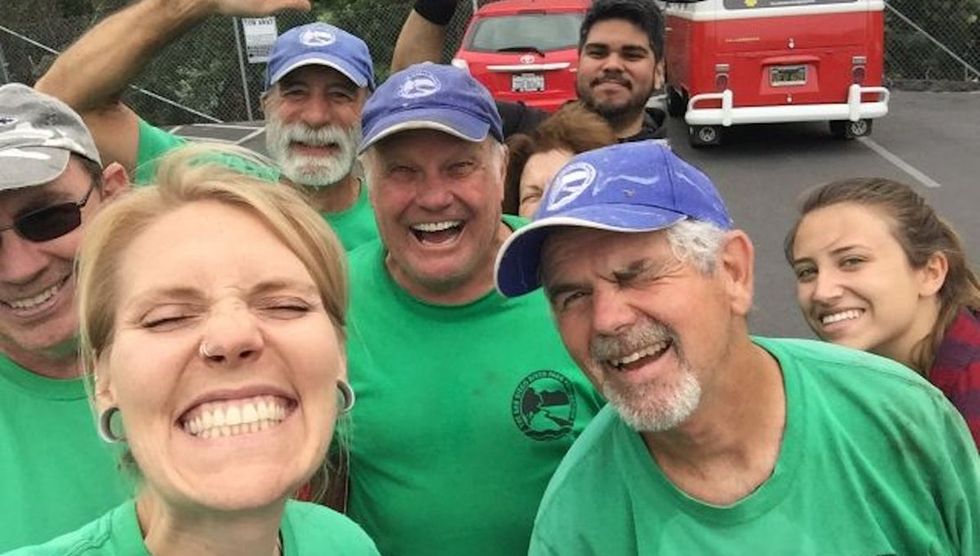The San Diego River is fighting a battle against trash. This team is helping it win.

There are many words you could use to describe the San Diego River: beautiful, vital, and majestic only scratch the surface.

If you've ever been to San Diego, you've likely heard some people refer to the river as an "emerald ribbon." It's 52 miles long and winds its way down some of the most vibrant vistas in southern California.
Walking along the riverbank, you may see one of the hundreds of species of birds that live or migrate through the area including the black-chinned hummingbird, the California condor, and the golden eagle.
On the ground, you might see a brush rabbit. Or come face-to-face with a grey fox. And, if you're really having a good animal-spotting day, you may run across a mule deer. You'll definitely brush by an abundance of vibrant plants.
Unfortunately, you'll also likely see trash.
While we all know that natural parks and waterways should be treated with respect and care, we still have a tendency to leave our litter without being mindful of it. And it often ends up polluting green spaces like The San Diego River.
Some of this trash is storm debris that washes its way down explains Juan Salgado, a volunteer leader with The San Diego River Park Foundation.
Other trash is carried into the river by the wind. But there's another, less accidental reason trash accumulates in the water and on the riverbank: People toss their garbage from their car windows as they drive by the river. While they may not think much of it, the empty soda cans and chip containers build up, endangering the wildlife that depend on that river.
It's the reason Salgado spent over 175 hours last year volunteering with The SDRPF. "I saw the massive amounts of trash," he says. He knew he had to do something about it.
The San Diego River Park Foundation is on a mission to restore the river to its original glory. Its volunteers are making that mission a reality.
"The San Diego River Park Foundation engages the community to create a better future for our San Diego River," says Ally Welborn, SDRPF's Community Engagement Manager. "Our vision includes a 52-mile river-long system of parks, trails, and open spaces."
"The San Diego River Park Foundation has a vision of achieving a trash-free river." This will not only make riparian habitats healthy for plants and animals, but also keep local green spaces beautiful and safe for people to relax and recreate in."
Volunteers are a vital part of this goal. To help keep the San Diego River trash-free, the organization appoints volunteers to scout ahead and find trash. Then, the SDRPF mobilizes volunteers to clean up the area. In 2018, they had 2,050 people helping with this work.
"Between these two tasks, volunteers are out along the River at least four times per week," says Welborn.
"Some people come out two or more times a week to haul soggy cushions, dig buried bicycle wheels out of the ground, and load heavy trash bags."
And if you want to help the river without actually getting your hands dirty, you can do that, too. All the organization's trash bags, trash pickers, gloves, and dumpsters come from donations from people who also want to see the river clean.
The cleaning The SDRPF has done isn't just important. It's transformative.

At one point, there was so much trash in parts of the river that volunteers had to wade into it hip-deep. These areas now, Welborn says, are nearly trash-free.
"The difference that dedicated volunteerism and directed enthusiasm can make is astounding!"
For volunteers like Salgado, it's rewarding to be able to see the amazing difference he's made by helping de-trash.
"It's incredibly gratifying after three hours of digging through mud and dirt and lugging 40-50 pound bags of trash uphill, to look back on the space I just worked on and see nothing but the dirt, grass, and water that should be the only things there," he says.
"Our efforts have turned something that most people thought was an unlined storm drain into a beautiful bit of nature that runs directly through the center of a huge city."
Of course, that feeling of pride sometimes comes with a tinge of disappointment. The battle with trash is never-ending. But it can be won. It just requires all of our support.
If you want to help keep nature clean, beautiful, and inhabitable, you absolutely can. It just takes commitment, and sometimes, getting a little dirty.
"The problem of trash in local green spaces is an ongoing issue," Welborn says. "For anyone who's interested in solving this problem, local organizations and dedicated volunteerism can make a real difference."
Getting involved is as easy as looking for cleanups in your local area. Or starting one yourself. If you do the latter, Welborn offers this piece of advice: Be prepared for the enthusiasm to be so infectious that you won't be able to help coming back to continue working to make the green spaces pristine.
"The atmosphere of a cleanup is so uplifting," she says. "Everyone is working hard, collaborating, and cracking jokes. Once you come to one, you might get hooked!"
Clorox believes clean has the power to transforms lives, which is why they've partnered with Upworthy to promote those same traits in people, actions and ideas. Cleaning up and transformation are important aspects of many of our social good stories. Check out the rest in the campaign to read more.






 TikTok · Ale
TikTok · Ale
 Autumn created this piece when she was just 5 years old.Autumn de Forest
Autumn created this piece when she was just 5 years old.Autumn de Forest  Autumn de Forest paints Autumn de Forest
Autumn de Forest paints Autumn de Forest  An Autumn de Forest paintingAutumn de Forest
An Autumn de Forest paintingAutumn de Forest 
 Autumn de Forest stands with the Pope who looks at one of her paintings Autumn de Forest
Autumn de Forest stands with the Pope who looks at one of her paintings Autumn de Forest 
 A menacing man asks that you say his name.
A menacing man asks that you say his name.  Spider-Man dances like nobody's watching.
Spider-Man dances like nobody's watching. 

 Angelo and Jennifer were a happy couple.
Angelo and Jennifer were a happy couple. Angelo and Jennifer
Angelo and Jennifer  Jennifer was diagnosed with cancer in 2008.
Jennifer was diagnosed with cancer in 2008. Her diagnosis came only five months after they were married.
Her diagnosis came only five months after they were married. Losing hair is a common side effect of cancer treatment.
Losing hair is a common side effect of cancer treatment. Angelo and Jennifer decided to document her cancer journey.
Angelo and Jennifer decided to document her cancer journey. Cancer can be lonely sometimes.
Cancer can be lonely sometimes.  Not everyone understands the journey.
Not everyone understands the journey. They captured the ups and the downs.
They captured the ups and the downs.  They also captured the love and heartbreak.
They also captured the love and heartbreak. Small joys are part of the journey.
Small joys are part of the journey. Celebrating Jennifer's 40th birthday
Celebrating Jennifer's 40th birthday Having a support system makes a big difference.
Having a support system makes a big difference.  Every photo tells a story.
Every photo tells a story. There is love in every image.
There is love in every image. And then the after began.
And then the after began. Jennifer's tombstone reads "I loved it all."
Jennifer's tombstone reads "I loved it all." 